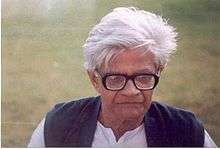Amal Kumar Raychaudhuri
| Amal Kumar Raychaudhuri | |
|---|---|
 | |
| Born |
14 September 1924 Barisal, East Bengal, British India (Now Bangladesh) |
| Died | 18 June 2005 (aged 80) |
| Residence | India |
| Nationality | Indian |
| Fields | Physics |
| Institutions |
Asutosh College[1] Indian Association for the Cultivation of Science Presidency College, Kolkata |
| Alma mater | Presidency College of the University of Calcutta |
| Known for | Raychaudhuri equation |
Amal Kumar Raychaudhuri (Bengali: অমল কুমার রায়চৌধুরী; 14 September 1923 – 18 June 2005) was a leading Indian physicist, renowned for his research in general relativity and cosmology. His most significant contribution is the eponymous Raychaudhuri equation, which demonstrates that singularities arise inevitably in general relativity and is a key ingredient in the proofs of the Penrose–Hawking singularity theorems.[2]
Raychaudhuri was also revered as a teacher during his tenure at Presidency College, Kolkata. Many of his students have gone on to become established scientists.
Career
Raychaudhuri was born in a Baidya family, originally hailing from Barisal. Raychaudhuri had his early education in Tirthapati Institution and completed matriculation from Hindu School, Kolkata. [3] After earning his master's degree, Raychaudhuri spent four years doing experimental work. During this time, working in complete isolation, he taught himself differential geometry and the theory of general relativity.
He earned B.Sc. from the Presidency College in 1942 and M.Sc in 1944 from Calcutta University and e joined Indian Association of Cultivation of Science (IACS) in 1945 as a research scholar. In 1952, he took a research job with the Indian Association for the Cultivation of Science (IACS), but to his frustration was required to work on the properties of metals rather than general relativity. Despite these adverse pressures, he was able to derive and publish the equation which is now named for him a few years later.
Some years later, having learned that his 1955 paper was highly regarded by notable physicists, such as Pascual Jordan, Raychaudhuri was sufficiently emboldened to submit a doctoral dissertation, and received his degree in 1959.
In 1961, Raychaudhuri joined the faculty of his alma mater, Presidency College then affiliated with the University of Calcutta.
Ironically, his work was not widely recognized in India until the nineteen seventies, when he became a well known scientific figure. Shortly before his death, a documentary film on his career was completed.[4]
Notes
- ↑ http://www.telegraphindia.com/1050627/asp/knowhow/story_4907454.asp
- ↑ http://www.thehindu.com/sci-tech/science/no-big-bang-the-universe-was-there-all-along-studies/article6959499.ece
- ↑ "Amal Kumar Raychaudhuri". ebscohost.com. April 2008. Retrieved September 4, 2015.
- ↑ Youtube link (https://www.youtube.com/watch?v=i9_hm2qe34s)
References
- Dadhich, Naresh (2005), "Amal Kumar Raychaudhuri (1923–2005)" (PDF), Current Science, 89: 569–570
- Narlikar, J. V. (January 2006), "Amal Kumar Raychaudhuri" (PDF), Biographical Memoirs of Fellows of the Indian National Science Academy: 169
- Sen, Parongama (April 2008), "The Legacy of Amal Kumar Raychaudhuri" (PDF), Biographical Memoirs of Fellows of the Indian National Science Academy: 309–309
- Interview with Professor Amal Kumar Raychaudhuri (2003), Part 1 & Part 2